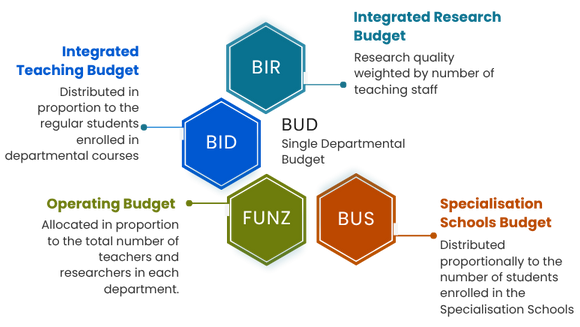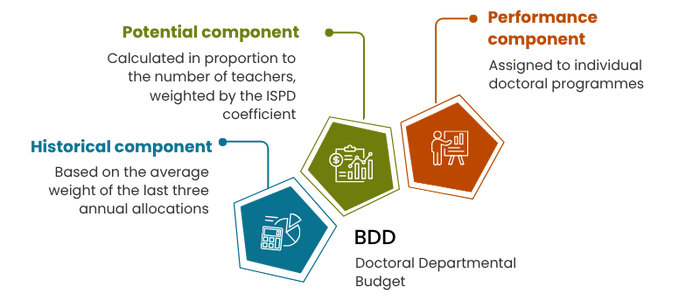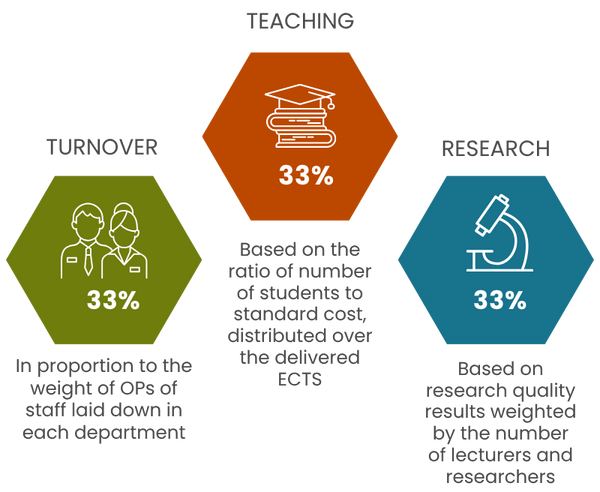Below are the principles and parameters that guide the distribution of resources, with a focus on fairness, sustainability and the achievement of institutional objectives.
The main annual allocations concern, from a financial point of view, the Single Departmental Budget (BUD) and the Doctoral Departmental Budget (BDD) and, from the point of view of teaching staff resources, the distribution of the hiring capacity.
Single Departmental Budget (BUD)

Each year, the University allocates the Single Departmental Budget (Budget Unico Dipartimentale, or BUD), broken down into the following specific budgets:
- BIR – Integrated Research Budget
- BID – Integrated Teaching Budget
- FUNZ – Operating Budget
- BUS – Specialisation Schools Budget
Integrated Research Budget (BIR)
The BIR is distributed on the basis of the number of teachers-researchers, weighted as follows:
- 65% on the basis of the ISPD (2015–2019 VQR), on a scale of 0.75–1.5;
- 35% based on the FFABR index for newly hired staff from 2021 to 2023 (2018–2022 publications), also on a scale of 0.75–1.5.
To balance any disparities between scientific areas in terms of access to external funding, the final departmental weights are adjusted with the following coefficients:
- Science Area: 1.10
- Technology Area: 0.90
- Medical Area: 1.00
- Humanities Area: 1.10
- Social Area: 1.00
Integrated Teaching Budget (BID)
The BID is distributed in proportion to the regular students enrolled in departmental courses, weighted by the class coefficients as defined by the Ordinary Financing Fund (FFO) Standard Cost. Additional coefficients apply for students enrolled in international programmes.
A portion of the fund is also distributed on the basis of the indicators relating to:
- the active course years;
- the degree of internationalisation (regular international students, graduates with at least 12 CFUs earned abroad).
Operating Budget (FUNZ)
The FUNZ is allocated in proportion to the total number of teachers and researchers in each department.
Specialisation Schools Budget (BUS)
The BUS is distributed proportionally to the number of students enrolled in the Specialisation Schools in the previous academic year.
Doctoral Departmental Budget (BDD)

The BDD is distributed on the basis of the criteria divided into three components:
- Potential component: calculated in proportion to the number of teachers, weighted by the ISPD coefficient;
- Historical component: based on the average weight of the last three annual allocations;
- Performance component: assigned to individual doctoral programmes and composed of:
- 30% based on the Board’s quality indicators;
- 15% internationalisation (applicants and enrolments);
- 10% collaboration with industry;
- 15% attractiveness of enrolments from other universities.
Allocation of Hiring Capacity (Punti Organico)

The system for distributing available Punti Organico is based on three main components: Turnover, Teaching, and Research.
- The Turnover component is allocated proportionally to the weight of the Punti Organico of the staff departures in each department, in relation to the total number across the University.
- The Teaching component follows a criterion similar to that used for allocating the Single Departmental Budget (Budget Unico Dipartimentale, or BUD). It is calculated on the basis of the number of regular students, weighted by the standard cost coefficients and distributed among the departments in proportion to the university educational credits (CFUs) awarded by teachers in the various degree programmes.
- The Research component is allocated on the basis of the number of active teachers-researchers on a given date, by applying the following weights:
- 65% based on the Standardised Departmental Performance Indicator (ISPD) relating to the 2015–2019 Research Quality Evaluation (VQR), normalised on a continuous scale from 0.75 (minimum) to 1.5 (maximum);
- 35% based on the Funding of Basic Research Activities (FFABR) productivity index for newly hired staff from 2021 to 2023, calculated using the 2018-2022 Composite Publications Index, also scaled from 0.75 to 1.5.
